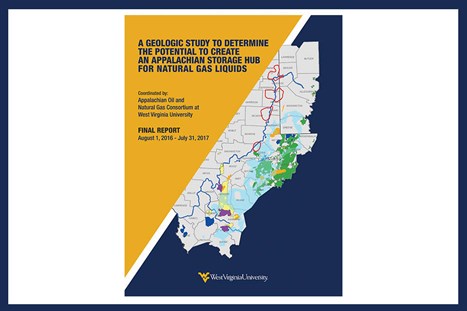Research team lays foundation for US gas storage hub in Appalachia
MORGANTOWN, West Virginia—The region around West Virginia, Pennsylvania and Ohio has abundant natural gas resources. The three states are working to turn those resources into economic growth. West Virginia University (WVU)-led research is helping with the effort.
On August 29, WVU is releasing to the public a study that shows how the region can support storage facilities that are critical for attracting petrochemical and related industries to the area. Researchers will present the data at a technical workshop in Canonsburg, Pennsylvania, hosted by the Eastern Petroleum Technology Transfer Council, PTTC, at WVU.

"Appalachia is poised for a renaissance of the petrochemical industry due to the availability of natural gas liquids," said Brian Anderson, director of the WVU Energy Institute.
"A critical path for this rebirth is through the development of infrastructure to support the industry. The Appalachian Storage Hub study is a first step for realizing that necessary infrastructure."
Study methodology shows great resource promise. Led by Doug Patchen, director of the WVU Appalachian Oil and Natural Gas Consortium and the Eastern PTTC, researchers from the geological surveys in West Virginia, Pennsylvania and Ohio studied geologic formations that could offer suitable locations for developers to build underground facilities to store natural gas liquids from Marcellus and Utica wells.
The team identified and mapped all potential options for subsurface storage of NGL along the Ohio River from southwestern Pennsylvania to eastern Kentucky, and the Kanawha River in West Virginia. The researchers focused on three options for subsurface storage.
One option includes areas where the Salina F Salt is at least 100 ft thick and suitable for solution mining, a type of mining that uses a liquid, such as water injected through a borehole, to dissolve and extract salts and minerals.
Another option includes areas where the Greenbrier Limestone is present 1,800 ft to 2,000 ft below the surface and is at least 40 ft thick.
Converting existing sandstone reservoirs in depleted gas fields and inactive gas storage fields to NGL storage is the third option.
Previously, the consortium had conducted studies of the Marcellus and Utica shale gas plays. Results from those studies have been used by both small producers, such as Northeast Natural Energy, and large multinationals, such as ExxonMobil, and have helped fuel the region's shale gas boom.
"Jump-starting" the midstream. This latest work was conducted as part of the Tri-State Shale Coalition, a cross-border collaboration among Ohio, Pennsylvania and West Virginia. A public-private partnership, the coalition brings together workforce development organizations, academic institutions and economic development groups to strategically advance the area as a "super-region" for petrochemicals, plastics fabrication and advanced manufacturing jobs and investments.
"We expect the new storage hub study to be even bigger than WVU's Utica study," said Cory Dennison, president and CEO of Vision Shared. "These results can jump start midstream developers looking to tap shale gas opportunities here in West Virginia and throughout the region."
"Having natural gas liquids storage capacity in the greater region is critical to fully realizing the potential of the shale gas resources found in our three states," said David Ruppersberger, president of the Pittsburgh Regional Alliance, the economic development marketing affiliate of the Allegheny Conference.
"Shell's decision to build a world-scale petrochemical facility here is game-changing and shines a spotlight on fresh opportunities in this part of the country. Natural gas storage will do the same—positioning us to attract additional ethane crackers and other petrochemical investments, as well as supporting further upstream and midstream development."
"Altogether this will help the tri-state region achieve recognition as a hub for petrochemical-related activity, alongside the US Gulf Coast, and that's something no one would have imagined a decade or so ago. Our opportunity is tremendous," said Ruppersberger.

- ExxonMobil halts 1-Bft3d blue hydrogen project in Texas
- Aramco and Yokogawa commission multiple autonomous control AI agents at Fadhili gas plant
- Ukraine will resume gas imports via Transbalkan route in November
- Mitsubishi to inject $260 MM into Brunei LNG project
- Freeport LNG (U.S.) on track to take in more natgas on Thursday after unit outage



Comments